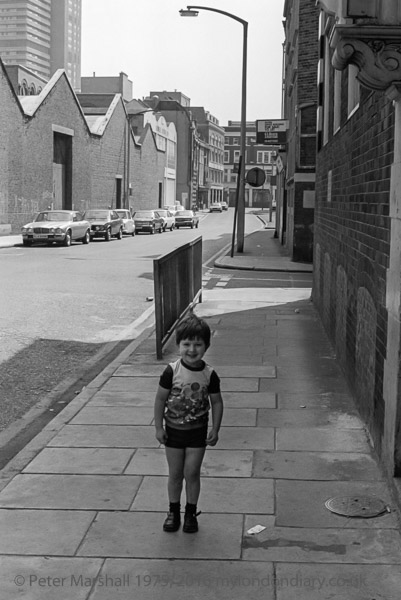London 1978
Peter MARSHALL

Child on street, Southwark, 1978
15j42: Southwark, children, people
This is one of eleven frames on the end of a roll of film which begins at home and suggests that I had set out walking from Waterloo Station. Several previous frames show Dolben St and Bear Lane, south of Southwark St, and I think this is taken on Unions St, outside the 1907 Shaftestbury Society 'The Mint & Gospel Lighthouse Mission', perhaps an appropriate place for this young boy who saw my camera and pleaded 'Take my pictures, Mister'. I wonder if someone will see this picture and recognise themselves 40 years on.
The building is just before the corner of Redcross Way, and the tower at the left is Guy's Hospital and the street at the end Borough High St, where the building on the corner of Newcomen St is still recognisable. The factory at left has been demolished and part of the site is now the Crossbones Graveyard, a medieval paupers' burial ground and now a memorial site, but the rather distinctive works further down the street has been replaced by a rather mundane block which takes some motifs from the building in Maidstone Building Mews whose upper windows are visible here.
The Crossbones burial ground was closed in 1853 when it was "completely overcharged with dead" and was sold as a building site in 1883, prompting much local opposition, with the sale being declared null and void the following year. But much of the human remains were removed to Brookwood cemetery after which the site was built over. Part was needed for a substation for the Jubilee Line extension and in 1992 there was an archaeological dig in a small area which uncovered 148 graves dating from 1800-1853, a third being of perinatal children and another 11% under a year old. The adults were mainly women over 36. Deaths during childbirth were then common, and older women were at greater risk. Southwark at that time was probably one of the most unhealthy areas of the country and it is thought that these represent a very small percentage of the bodies still underground.
The unconsecrated graveyard was thought to have been established for the prostitutes or "Winchester Geese", women licensed by the Bishop of Winchester to work in the Liberty of the Clink, though later it was simply a pauper's graveyard for St Saviour's parish. Writer John Constable, also known as urban shaman John Crow, produced 'The Southwark Mysteries', plays and poems inspired by the site, and the Friends of Cross Bones hold monthly vigils in the memorial garden, with a larger event at Halloween.